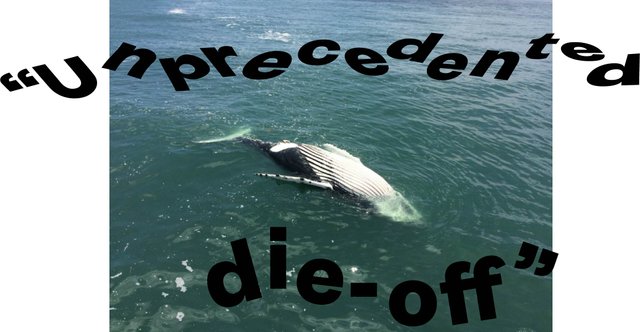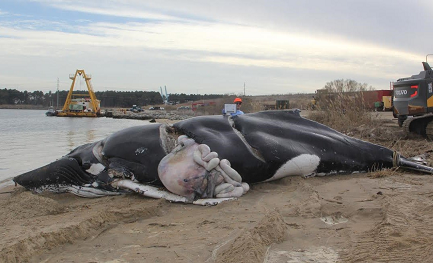Toxic algae caused by climate change might be killing scores of whales, and scientists are getting worried

Perched in a tiny zodiac, Tonya Wimmer and a team of scientists jetted into the Gulf of St. Lawrence last week, the Magdalen Islands visible in the distance. Their destination: an “absolutely mammoth” 50-foot-long right whale that was among five others found floating in the ocean, dead.
The stench of the bloated body filled the air.
Then, a vet on the team climbed on top of the floating whale, sat on it, and began hacking into the carcass to take samples.
The whale was the latest victim of what scientists are calling an “unprecedented die-off” of the endangered species in the Gulf of St. Lawrence since early June — and part of a larger pattern of “unusual mortality events” involving whales in recent years. With only 525 North Atlantic right whales alive today, the six deaths account for one percent of the entire population.
Canadian and American scientists are towing the bodies of three of the dead right whales to the shores of Prince Edward Island this week to be examined.
The cause of death is unknown, but vets and scientists will perform necropsies — whale autopsies — on the retrieved bodies to determine whether ship strikes, entanglement in fishing gear, or toxic algal blooms could be to blame.
 Dead stranded humpback whale showing evidence of pre-mortem propeller injuries. Photo Credit: Virginia Aquarium
Dead stranded humpback whale showing evidence of pre-mortem propeller injuries. Photo Credit: Virginia Aquarium
Scientists believes warming ocean temperatures due to climate change could be triggering more toxic algal blooms that could be harming whales and other marine mammals. Although it was rare to see marine mammal deaths from harmful algal blooms 20 years ago, the rate of these mass deaths is escalating and now more than 40 percent of marine mammal strandings in the US have been attributed to HAB toxins in the last two decades, according to one 2014 study.
Since January 2016, 44 whales have been found dead along the east coast of the United States in circumstances that authorities call “unusual.” Of the 20 whales examined, 10 showed evidence of being hit by boats. But the other 34 deaths remain a mystery.
And in 2015, nearly 60 whales were found dead off the coast of Alaska and British Columbia. In 2015 there was a huge spike in whales dying off the shores of Alaska, with 45 fin, humpback and gray whales found dead. The corpses of 14 large whales were also found off the coast of British Columbia that year.
Scientists are investigating the events separately and there is no evidence the three unusual mortality events are connected. However, British Columbia scientists that looked into the 2015 die-off have flown to PEI to investigate the recent deaths of the six right whales.
They were found between June 2 and June 23, spread out in the Gulf of St. Lawrence. One of the whales was tangled in fishing gear, but it’s not clear whether that happened before or after its death.
“At this stage there are some theories in terms of what could possibly kill this many individuals in a population, but we don’t know which one it is,” Wimmer, director of the Marine Animal Response Society, told VICE News. “It could be anything from toxic algae, so something in the environment that affected the food they eat, which is usually some sort of toxic algal bloom, but they also are a species that are commonly threatened by vessel strikes and entanglement in fishing gear. This is why it’s been so important that we can collect the animals.”
According to the Department of Fisheries and Oceans, collisions with vessels, entanglement in fishing gear and underwater noise are the biggest threats to right whales.
“We haven’t seen a die-off of right whales like this where you have this many animals that have died in one location,” said Wimmer.
“We haven’t seen a die-off of right whales like this where you have this many animals that have died in one location.”
Over on the west coast, scientists were unable to find a conclusive cause for why 60 whales died at once in 2015, although they suspected the deaths were linked to the “warm blob” — an area of warmer than normal ocean water that may have triggered toxic algal blooms.
They weren’t able to retrieve any of the whales stranded in Alaska. Of the 14 whales found dead in BC, scientists performed necropsies on eight.
Of those eight, four had high levels of domoic acid, a neurotoxin created by harmful algal blooms. And two of those four also showed signs of possible ship strikes.
Paul Cottrell, DFO marine mammal coordinator for the west coast based in Vancouver, said it was possible the neurotoxin affected the whales’ behaviour making them more likely to be struck by ships, but emphasized there was “no smoking gun” and it’s not possible to know for sure what killed them.
Cover: Floating whale offshore of Delaware. Photo credit: Marine Education, Rehabilitation and Research Institute